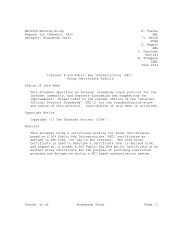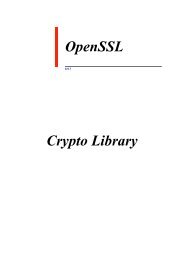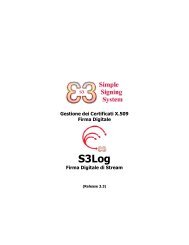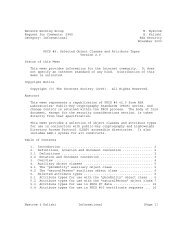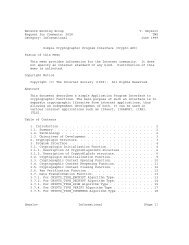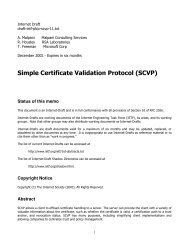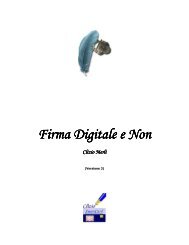E-mail Security: S/MIME - Clizio.com
E-mail Security: S/MIME - Clizio.com
E-mail Security: S/MIME - Clizio.com
You also want an ePaper? Increase the reach of your titles
YUMPU automatically turns print PDFs into web optimized ePapers that Google loves.
E-<strong>mail</strong> <strong>Security</strong>: S/<strong>MIME</strong><br />
What is S/<strong>MIME</strong>?<br />
Secure / Multipurpose Internet Mail Extension<br />
a security enhancement to <strong>MIME</strong><br />
provides similar services to PGP<br />
based on technology from RSA <strong>Security</strong><br />
industry standard for <strong>com</strong>mercial and organizational use<br />
RFC 2630, 2632, 2633<br />
RFC 822<br />
<br />
<br />
<br />
<br />
defines a format for text messages to be sent using e-<strong>mail</strong><br />
Internet standard<br />
structure of RFC 822 <strong>com</strong>pliant messages<br />
- header lines (e.g., from: …, to: …, cc: …)<br />
- blank line<br />
- body (the text to be sent)<br />
example<br />
Date: Tue, 16 Jan 1998 10:37:17 (EST)<br />
From: “Levente Buttyan” <br />
Subject: Test<br />
To: afriend@otherhost.bme.hu<br />
Blablabla<br />
Problems with RFC 822 and SMTP<br />
<br />
<br />
<br />
<br />
<br />
executable files must be converted into ASCII<br />
various schemes exist (e.g., Unix UUencode)<br />
a standard is needed<br />
text data that includes special characters (e.g., Hungarian text)<br />
some servers<br />
- reject messages over a certain size<br />
- delete, add, or reorder CR and LF characters<br />
- truncate or wrap lines longer than 76 characters<br />
- remove trailing white space (tabs and spaces)<br />
- pad lines in a message to the same length<br />
- convert tab characters into multiple spaces
<strong>MIME</strong><br />
<br />
<br />
<br />
defines new message header fields<br />
defines a number of content formats (standardizing representation of multimedia<br />
contents)<br />
defines transfer encodings that protects the content from alteration by the <strong>mail</strong> system<br />
<strong>MIME</strong> - New header fields<br />
<br />
<br />
<br />
<br />
<br />
<strong>MIME</strong>-Version<br />
Content-Type<br />
- describes the data contained in the body<br />
- receiving agent can pick an appropriate method to represent the content<br />
Content-Transfer-Encoding<br />
- indicates the type of the transformation that has been used to represent the body of<br />
the message<br />
Content-ID<br />
Content-Description<br />
- description of the object in the body of the message<br />
- useful when content is not readable (e.g., audio data)<br />
<strong>MIME</strong> – Content types and subtypes<br />
<br />
<br />
<br />
<br />
<br />
<br />
<br />
text/plain, text/enriched<br />
image/jpeg, image/gif<br />
video/mpeg<br />
audio/basic<br />
application/postscript, application/octet-stream<br />
multipart/mixed, multipart/parallel, multipart/alternative, multipart/digest (each part is<br />
message/rfc822)<br />
message/rfc822, message/partial, message/external-body<br />
<strong>MIME</strong> – Transfer encodings<br />
7bit<br />
- short lines of ASCII characters<br />
8bit<br />
- short lines of non-ASCII characters<br />
binary<br />
- non-ASCII characters<br />
- lines are not necessarily short<br />
quoted-printable<br />
- non-ASCII characters are converted into hexa numbers (e.g., =EF)<br />
base64 (radix 64)<br />
- 3 8-bit blocks into 4 6-bit blocks<br />
x-token<br />
- non-standard encoding
<strong>MIME</strong> – Example<br />
<strong>MIME</strong>-Version: 1.0<br />
From: Nathaniel Borenstein <br />
To: Ned Freed <br />
Date: Fri, 07 Oct 1994 16:15:05 -0700 (PDT)<br />
Subject: A multipart example<br />
Content-Type: multipart/mixed; boundary=unique-boundary-1<br />
This is the preamble area of a multipart message. Mail readers that<br />
understand multipart format should ignore this preamble. If you are reading<br />
this text, you might want to consider changing to a <strong>mail</strong> reader that<br />
understands how to properly display multipart messages.<br />
--unique-boundary-1<br />
Content-type: text/plain; charset=US-ASCII<br />
… Some text …<br />
--unique-boundary-1<br />
Content-Type: multipart/parallel; boundary=unique-boundary-2<br />
--unique-boundary-2<br />
Content-Type: audio/basic<br />
Content-Transfer-Encoding: base64<br />
... base64-encoded 8000 Hz single-channel mu-law-format audio data goes here<br />
...<br />
--unique-boundary-2<br />
Content-Type: image/jpeg<br />
Content-Transfer-Encoding: base64<br />
... base64-encoded image data goes here ...<br />
--unique-boundary-2—<br />
--unique-boundary-1<br />
Content-type: text/enriched<br />
This is enriched.as defined in RFC<br />
1896<br />
Isn’t it cool?<br />
--unique-boundary-1<br />
Content-Type: message/rfc822<br />
From: (<strong>mail</strong>box in US-ASCII)<br />
To: (address in US-ASCII)<br />
Subject: (subject in US-ASCII)<br />
Content-Type: Text/plain; charset=ISO-8859-1<br />
Content-Transfer-Encoding: Quoted-printable<br />
... Additional text in ISO-8859-1 goes here ...<br />
--unique-boundary-1—
S/<strong>MIME</strong> services<br />
<br />
<br />
<br />
<br />
enveloped data (application/pkcs7-mime; smime-type = enveloped-data)<br />
- standard digital envelop<br />
signed data (application/pkcs7-mime; smime-type = signed-data)<br />
- standard digital signature (“hash and sign”)<br />
- content + signature is encoded using base64 encoding<br />
clear-signed data (multipart/signed)<br />
- standard digital signature<br />
- only the signature is encoded using base64<br />
- recipient without S/<strong>MIME</strong> capability can read the message but cannot verify the<br />
signature<br />
signed and enveloped data<br />
- signed and encrypted entities may be nested in any order<br />
Cryptographic algorithms<br />
<br />
<br />
<br />
<br />
message digest<br />
- must: SHA-1<br />
- should (receiver): MD5 (backward <strong>com</strong>patibility)<br />
digital signature<br />
- must: DSS<br />
- should: RSA<br />
asymmetric-key encryption<br />
- must: ElGamal<br />
- should: RSA<br />
symmetric-key encryption<br />
- sender:<br />
- should: 3DES, RC2/40<br />
- receiver:<br />
- must: 3DES<br />
- should: RC2/40<br />
Securing a <strong>MIME</strong> entity<br />
<br />
<br />
<br />
<strong>MIME</strong> entity is prepared according to the normal rules for <strong>MIME</strong> message preparation<br />
prepared <strong>MIME</strong> entity is processed by S/<strong>MIME</strong> to produce a PKCS object<br />
the PKCS object is treated as message content and wrapped in <strong>MIME</strong>
PKCS7 “signed data”<br />
Version<br />
(Set of) Digest<br />
Algorithms<br />
Content Info<br />
Content type<br />
Content<br />
Set of certificates<br />
Set of CRLs<br />
Signer Info<br />
Version<br />
Signer ID (issuer and ser. no.)<br />
Digest Algorithm<br />
Authenticated Attributes<br />
Digest Encryption Alg.<br />
Encrypted digest (signature)
PKCS7 “enveloped data”<br />
Version<br />
Originator Info<br />
Recipient Info<br />
Version<br />
Recipient ID (issuer and s.no.)<br />
Key Encryption Algorithm<br />
Encrypted Content Info<br />
Encrypted Key<br />
Content type<br />
Content Encryption Alg.<br />
Encrypted Content
Enveloped data – Example<br />
Content-Type: application/pkcs7-mime; smime-type=enveloped-data;<br />
name=smime.p7m<br />
Content-Transfer-Encoding: base64<br />
Content-Disposition: attachment; filename=smime.p7m<br />
rfvbnj756tbBghyHhHUujhJhjH77n8HHGT9HG4VQpfyF467GhIGfHfYT6<br />
7n8HHGghyHhHUujhJh4VQpfyF467GhIGfHfYGTrfvbnjT6jH7756tbB9H<br />
f8HHGTrfvhJhjH776tbB9HG4VQbnj7567GhIGfHfYT6ghyHhHUujpfyF4<br />
0GhIGfHfQbnj756YT64V<br />
Clear-signed data – Example<br />
Content-Type: multipart/signed; protocol="application/pkcs7-signature";<br />
micalg=sha1; boundary=boundary42<br />
--boundary42<br />
Content-Type: text/plain<br />
This is a clear-signed message.<br />
--boundary42<br />
Content-Type: application/pkcs7-signature; name=smime.p7s<br />
Content-Transfer-Encoding: base64<br />
Content-Disposition: attachment; filename=smime.p7s<br />
ghyHhHUujhJhjH77n8HHGTrfvbnj756tbB9HG4VQpfyF467GhIGfHfYT6<br />
4VQpfyF467GhIGfHfYT6jH77n8HHGghyHhHUujhJh756tbB9HGTrfvbnj<br />
n8HHGTrfvhJhjH776tbB9HG4VQbnj7567GhIGfHfYT6ghyHhHUujpfyF4<br />
7GhIGfHfYT64VQbnj756<br />
--boundary42—
Key management<br />
<br />
<br />
S/<strong>MIME</strong> certificates are X.509 conformant<br />
key management scheme is between strict certification hierarchy and PGP’s web of trust<br />
- certificates are signed by certification authorities (CA)<br />
- key authentication is based on chain of certificates<br />
- users/managers are responsible to configure their clients with a list of trusted root<br />
keys<br />
K



